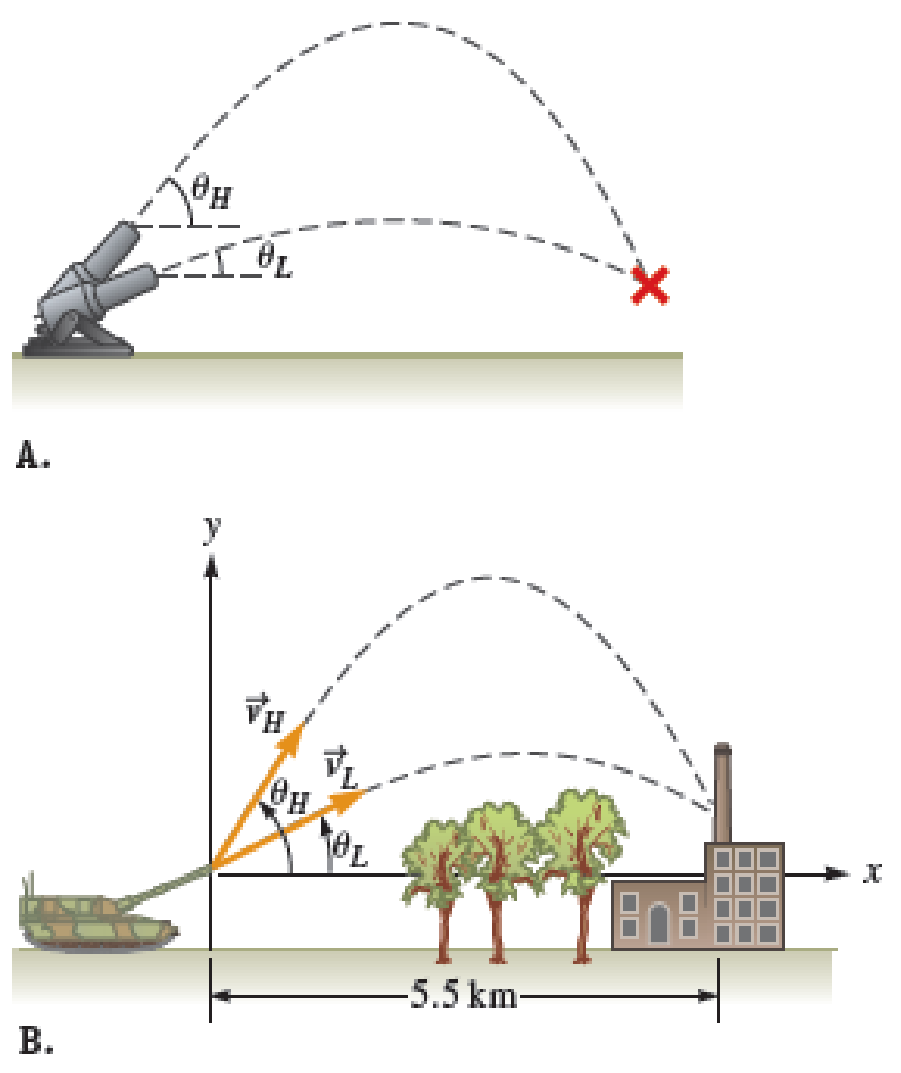
Concept explainers
Frequently, a weapon must be fired at a target that is closer than the weapon’s maximum range. To hit such a target, a weapon has two possible launch angles (Fig. P4.68A): one higher than 45° (θH) and one lower than 45° (θL). Although the displacement of the projectile is the same for the two angles, a projectile launched at θH has a longer flight time and a higher peak position than one launched at θL. Usually, some tactical situation makes one angle preferable to the other. For example, if the projectile must go over some nearby object such as a grove of trees, the higher angle may be desirable. A shorter flight time and therefore θL are preferable if the target is mobile.
In practice, many weapons are designed to operate either at angles lower than 45° or at angles higher than 45°, but not both. Tanks, for example, often must face mobile targets; to minimize the time the target has to move, tanks fire at low angles. Grenades, on the other hand, are launched at high angles because a soldier launching a grenade is often close to the target, but has no armor plating for protection. The high launch angle allows the soldier to stay out of sight by hiding behind some obstacle, and the longer flight time may make it possible for the soldier to move farther from the exploding grenade.

FIGURE P4.68
Imagine an unusual scenario in which a large gun mounted on a vehicle is required to hit an explosives factory (Fig. P4.68B). A huge explosion is expected, and there must be time for the gunner to retreat. A grove of trees provides cover. The maximum range of the gun is 17.6 km, and the maximum speed of the vehicle is 80.0 km/h. a. What is the muzzle speed v0? (Muzzle speed is the speed at which the projectile leaves the barrel of the gun.) b. The target is 5.5 km away. Find the low angle θL and the high angle θH at which the gunner may aim so as to hit the target. c. Find the time the projectile takes to hit the target for both angles. d. Assume the vehicle retreats at its maximum speed (80.0 km/h) to be as far from the ensuing explosion as possible. How far is it from the factory at the time of the explosion for each launch angle?
Trending nowThis is a popular solution!

Chapter 4 Solutions
EBK WEBASSIGN FOR KATZ'S PHYSICS FOR SC
- Show that the units 1 v2/Q = 1 W, as implied by the equation P = V²/R. Starting with the equation P = V²/R, we can get an expression for a watt in terms of voltage and resistance. The units for voltage, V, are equivalent to [? v2 v2 A, are equivalent to J/C ✓ X . Therefore, 1 = 1 = 1 A V1 J/s Ω V-A X = 1 W. . The units for resistance, Q, are equivalent to ? The units for current,arrow_forwardPlease solve and answer the question correctly please. Thank you!!arrow_forwardPlease solve and answer the question correctly please. Thank you!!arrow_forward
- According to the provided information answer the question accorrding to grade 11 physics Jerry has decided to give up his part-time job for a new career, cat-burglar! Jerry loves the idea of dressing up like a cat all day and of course the chance of meeting Cat Woman! On Jerry's first "job" he figures out his escape plan. He travels 3.0 km south for 15 minutes and then 8.0 km west for 1.5 hours before reaching his house. Draw a sketch diagram of the path he took with all the appropriate labels.arrow_forwardPlease solve and answer all parts of the question correctly please. Thank you!!arrow_forwardPlease solve and answer this question correctly please. Thank you!!arrow_forward
 Principles of Physics: A Calculus-Based TextPhysicsISBN:9781133104261Author:Raymond A. Serway, John W. JewettPublisher:Cengage Learning
Principles of Physics: A Calculus-Based TextPhysicsISBN:9781133104261Author:Raymond A. Serway, John W. JewettPublisher:Cengage Learning University Physics Volume 1PhysicsISBN:9781938168277Author:William Moebs, Samuel J. Ling, Jeff SannyPublisher:OpenStax - Rice University
University Physics Volume 1PhysicsISBN:9781938168277Author:William Moebs, Samuel J. Ling, Jeff SannyPublisher:OpenStax - Rice University Physics for Scientists and Engineers: Foundations...PhysicsISBN:9781133939146Author:Katz, Debora M.Publisher:Cengage Learning
Physics for Scientists and Engineers: Foundations...PhysicsISBN:9781133939146Author:Katz, Debora M.Publisher:Cengage Learning College PhysicsPhysicsISBN:9781285737027Author:Raymond A. Serway, Chris VuillePublisher:Cengage Learning
College PhysicsPhysicsISBN:9781285737027Author:Raymond A. Serway, Chris VuillePublisher:Cengage Learning Classical Dynamics of Particles and SystemsPhysicsISBN:9780534408961Author:Stephen T. Thornton, Jerry B. MarionPublisher:Cengage Learning
Classical Dynamics of Particles and SystemsPhysicsISBN:9780534408961Author:Stephen T. Thornton, Jerry B. MarionPublisher:Cengage Learning Glencoe Physics: Principles and Problems, Student...PhysicsISBN:9780078807213Author:Paul W. ZitzewitzPublisher:Glencoe/McGraw-Hill
Glencoe Physics: Principles and Problems, Student...PhysicsISBN:9780078807213Author:Paul W. ZitzewitzPublisher:Glencoe/McGraw-Hill





